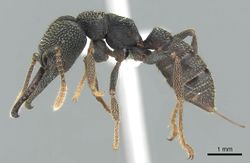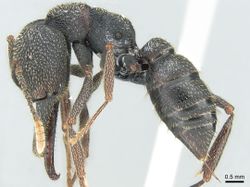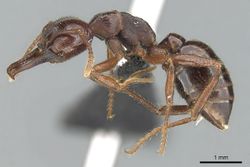Key to Malagasy Mystrium Species
A key to worker, queen and male Mystrium species in the Malagasy region. Based on: Yoshimura, M. & Fisher, B.L. 2014. A revision of the ant genus Mystrium in the Malagasy region with description of six new species and remarks on Amblyopone and Stigmatomma (Hymenoptera, Formicidae, Amblyoponinae). ZooKeys 394, 1–99. doi:10.3897/zookeys.394.6446
There are two keys: a worker and queen key, followed by a key to the known males.
Key to Workers and Queens
1
- Wings present and well developed. Wing sclerites fully developed even with wings removed (Fig. 7A). Both anterior and lateral ocelli distinct (Fig. 7C) . . . . . 2
 Figure 7. Female castes of Mystrium mysticum. A, C alate queen B worker D intercaste. A, B mesosoma in dorsal view C, D head in full-face view. |
- Wings absent or vestigial. Wing sclerites undeveloped or incomplete (Fig. 7B). Lateral ocelli absent (Fig. 7D) . . . . . 5
2
return to couplet #1
- Labrum with distinct longitudinal ridge on its middle portion (Fig. 8A). Distal portion of abdominal sternum VII with single pair of stout spines (Fig. 8C). Body size relatively large (HW>1.9 mm)(mysticum species group, part) . . . . . 3
 Figure 8. Female diagnostic characters of mysticum species group. A Mystrium rogeri B Mystrium barrybressleri C Mystrium mysticum D Mystrium mirror. A–D worker. A, B mandible in oblique anterior view C, D abdominal segment VII in lateral view. |
- Labrum without distinct longitudinal ridge on its middle portion (Fig. 8B). Distal portion of abdominal sternum VII with two pairs of stout spines (Fig. 8D). Body size relatively small (HW<1.7 mm)(camillae species group, part) . . . . . 4
3
return to couplet #2
- Setae (=hairs) on dorsal surface of head and pronotum simple (Fig. 9A). Anterior margin of clypeus convex (Fig. 9C) (queen and intercaste) . . . . . Mystrium mysticum
 Figure 9. Queens of mysticum species group. A, C Mystrium mysticum B, D Mystrium rogeri. A, B head to mesonotum in oblique lateral view C, D clypeus in oblique full-face view. |
- Setae (=hairs) on dorsal surface of head and pronotum spatulate (Fig. 9B). Anterior margin of clypeus straight or weakly concave (Fig. 9D) (queen and intercaste) . . . . . Mystrium rogeri
4
return to couplet #2
- Petiole short in dorsal view, 0.5× length of abdominal segment III (Fig. 10A). Setae on pronotal dorsum narrow and sharp on its apex. First flagellomere (third segment of antenna) distinctly shorter than pedicel (second segment of antenna) (Fig. 10C). Body yellow to yellowish brown (queen) . . . . . Mystrium barrybressleri
 Figure 10. Queens of camillae species group. A, C Mystrium barrybressleri B, D Mystrium labyrinth . A, B petiole and abdominal segment III in dorsal view C, D pedicel and flagellum in lateral view. |
- Petiole long in dorsal view, 0.7× length of abdominal segment III (Fig. 10B). Setae on pronotal dorsum spatulate and dull on its apex. First flagellomere as long as pedicel (Fig. 10D). Body blackish brown (queen) . . . . . Mystrium labyrinth
5
return to couplet #1
- Ventral half of vertex unsculptured, smooth (Fig. 11A). Labrum with distinct longitudinal ridge on its middle portion (as in Fig. 8A). Distal portion of abdominal sternum VII with single pair of stout spines (Fig. 8D). Anterior ocellus sometimes present (mysticum species group, worker and intercaste) . . . . . 6
- Ventral half of vertex sculptured (Fig. 11B). Labrum without distinct longitudinal ridge on its middle portion (as in Fig. 8B). Distal portion of abdominal sternum VII with two pairs of stout spines (Fig. 8D). Ocelli absent . . . . . 7
6
return to couplet #5
- Anterior margin of clypeus convex (as in Fig. 9C). Among same-sized individuals, combination of following characters usually observed: sculpture relatively shallow and weak on lateral surface of pronotum; difference in width of dorsal surface of mandible larger between mandibular shaft (narrowest part) and distal portion (widest part) (Fig. 12A); petiole in dorsal view relatively wider (worker and intercaste) . . . . . Mystrium mysticum
 Figure 9. Queens of mysticum species group. A, C Mystrium mysticum B, D Mystrium rogeri. A, B head to mesonotum in oblique lateral view C, D clypeus in oblique full-face view. |
- Anterior margin of clypeus straight or weakly concave (as in Fig. 9D). Among same sized individuals, combination of following characters usually observed: sculpture relatively deep and strong on lateral surface of pronotum; difference in width of dorsal surface of mandible smaller between mandibular shaft (narrowest part) and distal portion (widest part) (Fig. 12B); petiole in dorsal view relatively narrower (worker and intercaste) . . . . . Mystrium rogeri
7
return to couplet #5
- Head dorsum and pronotum strongly to weakly and regularly reticulate (Fig. 13A). No deep longitudinal furrow on midline of pronotum. Second maxillary palpomere shorter than third (Fig. 13C) (camillae group, worker) . . . . . 8
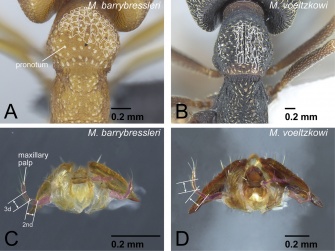 Figure 13. Worker diagnostic characters of camillae species group. A Mystrium barrybressleri B Mystrium voeltzkowi C Mystrium barrybressleri D Mystrium voeltzkowi. A–D worker. A, B pronotum in dorsal view C, D mouthparts in oblique lateral view. |
- Head dorsum and pronotum finely to roughly sculptured longitudinally, but not regularly reticulate (Fig. 13B). Pronotum often with deep longitudinal furrow along midline. Second maxillary palpomere longer than third (Fig. 13D) (voeltzkowi group) . . . . . 9
8
return to couplet #7
- First flagellomere segment of antenna distinctly shorter than pedicel (as in Fig. 10C). Genal tooth relatively short, distinctly failing to reach to anterior margin of lateral lobe of clypeus (Fig. 14A). No carina present on dorsal edge of metapleural gland bulla. Body size relatively small (HW<1.50 mm). Petiole relatively wider in dorsal view (PtI>195). Body yellowish brown to reddish brown (worker) . . . . . Mystrium barrybressleri
 Figure 14. Head of workers in camillae species group. A Mystrium barrybressleri B Mystrium labyrinth. |
- First flagellomere as long as pedicel (as in Fig 10D). Genal tooth relatively long, almost reaching anterior margin of lateral lobe of clypeus (Fig. 14B). Distinct carina present on dorsal edge of metapleural gland bulla. Body size relatively large (HW>1.70 mm). Petiole relatively narrower in dorsal view (PtI<185). Body reddish brown to black (worker) . . . . . Mystrium labyrinth
9
return to couplet #7
- Apical tooth strongly sclerotized, its apex darker than basal portion, strongly curving inward (Fig. 15A) (voeltzkowi group, worker) . . . . . 10
 Figure 15. Distal portion of the mandible of Mystrium voeltzkowi in mesal view. A worker B ergatoid queen. |
- Apical tooth moderately sclerotized, its apex same color as basal portion, straight and directed ventrally (Fig. 15B) (voeltzkowi group, ergatoid queen) . . . . . 15
10
return to couplet #9
- With head in posterior view, posterior face of vertex forming right or even acute angle with its dorsal face on median line, on lateral portion of vertex as steep as median portion (Fig. 16A) . . . . . 11
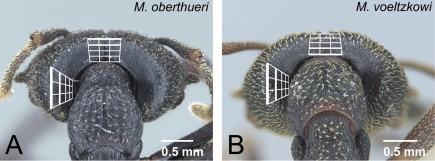 Figure 16. Vertex of workers in voeltzkowi species group. A Mystrium oberthueri B Mystrium voeltzkowi A, B head in posterior view. |
- With head in posterior view, posterior face of vertex forming blunt angle with its dorsal face on median line, lateral portion of vertex distinctly steeper than median portion (Fig. 16B) . . . . . 13
11
return to couplet #10
- Dorsal surface of pronotum without strong, deep, and thick longitudinal striae (Fig. 17A). Genal tooth undeveloped, distinctly fails to reach anterior margin of lateral lobe of clypeus in full-face view (Fig. 17C). Clypeal conical setae extremely small and short (Fig. 17C). Metanotal groove indistinct in lateral view. Mesonotum often not differentiated from propodeum in dorsal view (worker) . . . . . Mystrium janovitzi
 Figure 17. Differences in worker morphology between Mystrium janovitzi and Mystrium oberthueri. A Mystrium janovitzi B Mystrium oberthueri C Mystrium janovitzi (holotype) D Mystrium oberthueri. A, B mesosoma in dorsal view C, D clypeus and genal tooth in full-face view. |
- Dorsal surface of pronotum with strong, deep, and thick longitudinal striae (Fig. 17B). Genal tooth distinctly developed, almost reach to anterior margin of lateral lobe of clypeus in full-face view (Fig. 17D). Clypeal conical setae long (Fig. 17D). Metanotal groove shallow but distinct in lateral view. Mesonotum always clearly differentiated from propodeum in dorsal view . . . . . 12
12
return to couplet #11
- Anterior margin of clypeus straight (Fig. 18A). First flagellomere longer than pedicel (Fig. 18C). With mandible in dorsal view, width of visible surface on distal portion almost the same as on mandibular shaft (Fig. 18E) (worker) . . . . . Mystrium oberthueri
 Figure 18. Differences in worker morphology between Mystrium oberthueri and Mystrium eques. A Mystrium oberthueri B Mystrium eques (holotype) C, E Mystrium oberthueri D, F Mystrium eques. A, B head in full-face view C, D pedicel and flagellum in lateral view E, F mandible in dorsal view. |
- Anterior margin of clypeus strongly convex (Fig. 18B). First flagellomere as long as pedicel (Fig. 18D). With mandible in dorsal view, visible surface on distal portion slightly wider than on mandibular shaft (Fig. 18F) (worker) . . . . . Mystrium eques
13
return to couplet #10
- Anterior margin of clypeus strongly convex with long conical setae, of which median pair usually larger than adjacent pair (Fig. 19A) (worker) . . . . . Mystrium shadow
 Figure 19. Clypeus of workers in voeltzkowi species group. A Mystrium shadow (holotype) B Mystrium voeltzkowi. |
- Anterior margin of clypeus almost straight, with short conical setae, of which median pair usually smaller than adjacent pair (Fig. 19B) . . . . . 14
14
return to couplet #13
- Genal tooth relatively short, reaching or slightly exceeding basal line of lateral clypeal lobe (Fig. 20A). Eye relatively larger than in individuals of Mystrium voeltzkowi of same body size (Fig. 20C). Metapleural gland bulla weakly developed, posterior margin of propodeal declivity almost straight (Fig. 20E) (worker) . . . . . Mystrium mirror
 Figure 20. Differences in worker morphology between Mystrium mirror and Mystrium voeltzkowi. A, E Mystrium mirror B, D, F Mystrium voeltzkowi C Mystrium mirror. A, B head in full-face view C, D head in lateral view E, F mesosoma and petiole in lateral view. |
- Genal tooth relatively long, reaching to about half of lateral clypeal lobe (Fig. 20B). Eye relatively smaller than Mystrium mirror in individuals of same body size (Fig. 20D). Metapleural gland bulla strongly developed, posterior margin of propodeal declivity distinctly convex posteriorly on its ventral side (Fig. 20F) (worker) . . . . . Mystrium voeltzkowi
15
return to couplet #9
- With head in posterior view, posterior face of vertex forming right or even acute angle with its dorsal face on median line, lateral portion of vertex as steep as on median portion (Fig. 21A) . . . . . 16
 Figure 21. Vertex of ergatoid queens in voeltzkowi species group. A Mystrium eques B Mystrium shadow (paratype). A, B head in posterior view. |
- With head in posterior view, posterior face of vertex forming blunt angle with its dorsal face on median line, lateral portion of vertex distinctly steeper than median portion (Fig. 21B) . . . . . 18
16
return to couplet #15
- Anterior margin of clypeus strongly convex (Fig. 22A) (ergatoid queen) . . . . . Mystrium eques
 Figure 22. Clypeus of ergatoid queens in voeltzkowi species group. A Mystrium eques (paratype) B Mystrium oberthueri. A, B head in full-face view. |
- Anterior margin of clypeus almost straight (Fig. 22B) . . . . . 17
17
return to couplet #16
- Clypeal conical setae extremely short (Fig. 23A). First flagellomere as long as pedicel (Fig. 23C) (ergatoid queen) . . . . . Mystrium janovitzi
 Figure 23. Differences in ergatoid queen characters between Mystrium janovitzi and Mystrium oberthueri. A Mystrium janovitzi B Mystrium oberthueri C Mystrium janovitzi D Mystrium oberthueri. A, B head in full-face view C, D pedicel and flagellum in lateral view. |
- Clypeal conical setae moderately long (Fig. 23B). First flagellomere longer than pedicel (Fig. 23D) (ergatoid queen) . . . . . Mystrium oberthueri
18
return to couplet #15
- Metapleural gland bulla extremely well developed, expanding above propodeal spiracle (Fig. 24A). Propodeal declivity in lateral view strongly convex posteriorly on its ventral two thirds (ergatoid queen) . . . . . Mystrium voeltzkowi
 Figure 24. Propodeum of ergatoid queens of Mystrium voeltzkowi and Mystrium mirror in lateral view. A Mystrium voeltzkowi B Mystrium mirror (paratype). |
- Metapleural gland bulla weakly to moderately developed, not expanding above propodeal spiracle (Fig. 24B). Propodeal declivity in lateral view usually straight or convex posteriorly on its ventral third . . . . . 19
19
return to couplet #18
- Setae on pronotal dorsum almost simple, narrowing distally, with sharp apex (Fig. 25A). Anterolateral corner of head usually without spine, but sometimes with small spine. Vestigial wings often unclear and unrecognizable, or existing as quite small appendage (Fig. 25C) (ergatoid queen) . . . . . Mystrium mirror
- Setae on pronotal dorsum spatulate, widened distally and with sharp apex (Fig. 25B). Anterolateral corner of head with small spine. Vestigial wings clearly recognizable as appendages (Fig. 25D) (ergatoid queen) . . . . . Mystrium shadow
Key to Males
Males of Mystrium labyrinth and Mystrium eques are unknown.
1M
- Lateral ocellus relatively large and close to eye; distance between lateral ocellus and eye less than 1.2× maximum diameter of lateral ocellus (Fig. 26A). Eye large, occupying about 0.75× of head length (Fig. 26C). Body relatively brighter . . . . . 2M
- Lateral ocellus relatively small and distant from eye; distance between lateral ocellus and eye more than 1.2× maximum diameter of lateral ocellus (Fig. 26B). Eye relatively smaller, occupying 0.5-0.6× of head length (Fig. 26D). Body relatively darker . . . . . 3M
 Figure 26. Head of Mystrium males. A, C Mystrium mirror B Mystrium mysticum D Mystrium janovitzi. A, B in oblique dorsal view C, D full-face view. |
2M
return to couplet #1M
- Distal portion of aedeagus rounded (Fig. 27A). Basal ring gently extending basally (Fig. 27C) . . . . . Mystrium voeltzkowi
- Distal portion of aedeagus relatively sharp (Fig. 27B). Basal ring not extending basally (Fig. 27D) . . . . . Mystrium mirror
 Figure 27. Differences in male characters between Mystrium voeltzkowi and Mystrium mirror. A, C Mystrium voeltzkowi B, D Mystrium mirror. A, B aedeagus in lateral view C, D genital capsule in lateral view. |
3M
return to couplet #1M
- Abdominal tergum VIII punctured (Fig. 28A). Petiolar dorsum covered with rough, deep punctures (Fig. 28C). Eye relatively small, occupying about half of head . . . . . 4M
- Abdominal tergum VIII smooth and not punctured (Fig. 28B). Petiolar dorsum smooth, or covered with fine punctures, or at most shallow, irregular punctures (Fig. 28D). Eye relatively large, occupying about 0.6× of head length . . . . . 5M
4M
return to couplet #3M
- Basoventral expansion of aedeagus long, its distal portion relatively narrow and sharp (Fig. 29A) . . . . . Mystrium mysticum
- Basoventral expansion of aedeagus short, its distal portion relatively wide and rounded (Fig. 29B) . . . . . Mystrium rogeri
 Figure 29. Differences in male genital characters between Mystrium mysticum and Mystrium rogeri. A Mystrium mysticum B Mystrium rogeri. A, B aedeagus in lateral view. |
5M
return to couplet #3M
- With head in full-face view, dorsal margin of head straight (Fig. 30A) . . . . . Mystrium oberthueri
- With head in full-face view, dorsal margin of head somewhat rounded (Fig. 30B) . . . . . 6M
 Figure 30. Head of Mystrium males in full-face view. A Mystrium oberthueri (CASENT0179499) B Mystrium shadow. |
6M
return to couplet #5M
- Body size smaller (HW<1.20 mm). With head in full-face view, lateral ocelli clearly protruding from dorsal margin of head (Fig. 31A). On forewing, cu-a usually located at junction of Media (M) and Cubitus (Cu), sometimes slightly basal from junction (Fig. 31C). Petiole in dorsal view shorter, its length 0.5× of that of abdominal tergite III . . . . . Mystrium barrybressleri
- Body size larger (HW>1.50 mm). With head in full-face view, lateral ocelli reaching or failing to reach dorsal margin of head (Fig. 31B). On forewing, cu-a located far basal from junction of Media (M) and Cubitus (Cu) (Fig. 31D). Petiole in dorsal view longer, its length 0.6× or more of that of abdominal tergite III . . . . . 7M
 Figure 31. Mystrium males. A Mystrium barrybressleri B Mystrium janovitzi C Mystrium barrybressleri D Mystrium shadow. A, B head in full-face view C, D right forewing in dorsal view. |
7M
return to couplet #6M
- Posterior face of vertex gently rising from neck, posterior and dorsal faces almost continuous without division (Fig. 32A). Basoventral expansion of aedeagus relatively short (Fig. 32C) . . . . . Mystrium shadow
- Posterior face of vertex steeply rising from neck, posterior and dorsal faces clearly divided (Fig. 32B). Basoventral expansion of aedeagus relatively long (Fig. 32D) . . . . . Mystrium janovitzi
 Figure 32. Differences in male characters between Mystrium shadow and Mystrium janovitzi. A Mystrium shadow B Mystrium janovitzi C Mystrium shadow D Mystrium janovitzi. A, B head in posterior view C, D aedeagus in lateral view. |














